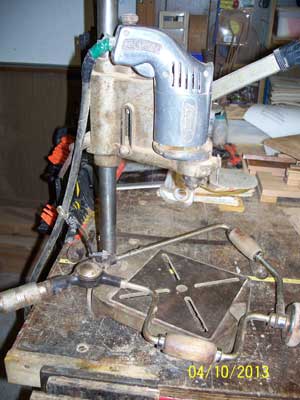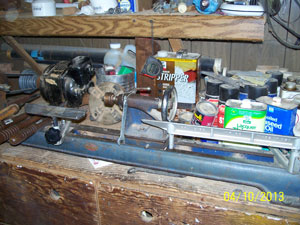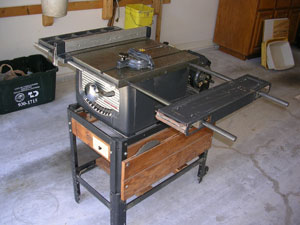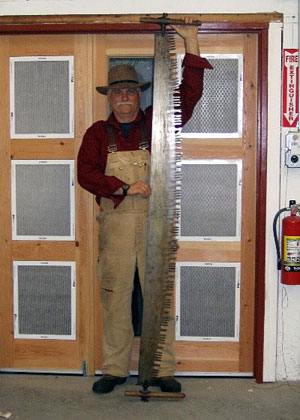
Table Saw Calibration
Before we get to all of the comments about old tools, we do have a comment about something else in last issue’s eZine — the WebSurfer’s Review discussion focusing on table saw calibration. – Editor
“I’m sorry, but .01” is a vast amount of difference in distance of front and back of a table saw blade from the miter slot. When you crosscut, if the back of the blade is closer to the board it will push the board over and the cut will have curvature. If the fence is this far out of line, you get burning and possibly kickback. I heel my blade so the difference is less than .01 mm (about .0005 in.) With my setup, it’s easier and more accurate to set the fence parallel to the slot than parallel to the blade directly, and if I know the slots are lined up with the blade, that works. I like to have the fence perfectly parallel to the blade because the ripped lumber I’m using is sometimes the piece that’s cut off, sometimes the piece that rides the fence.” – Morris C.
Old Tools
We also had many, many “blasts from the past” in response to last issue’s eZine, and the question in Rob’s editorial about the oldest working tool in your shop. In fact, it seems like we received enough responses to fill a history book (even the Internet didn’t have room for all of them). – Editor
“Being an ‘old’ woodworker and retired plumber (going on 84), I have a good many ‘old’ tools in my shop that I still use occasionally. One is a Milwaukee “hole shooter”: a small hand drill that I have in a little Milwaukee drill press that I purchased back in the 50s from Southern Pipe & Supply in Meridian, Mississippi that moved west with me to a little town on the Columbia River, Washougal, Washington. I use this item for the very small bits that won’t chuck in my modern floor model drill stand. A pre-1925 “Companion tools” wood lathe is my primary woodworking lathe. This tool also came west with me after being handed down to an older friend of mine by his father sometime prior to 1950 and then passed on to me. I have made the tool-rests and some of the head plates for bowl production. This lathe has provided me many, many hours of pleasure and is a wonderful tool after being set up in the fashion that I have. If you look close at the photo of the little drill press you’ll see lying behind the base of the drill press a “drawknife” that belonged to my great grandfather from the early 1900s. It’s not used anymore, but I keep it hanging on the wall for conversation.” – John T. Watts of Washougal, Washington
“I have a Montgomery Ward radial arm saw that I bought new many years ago. How long have Montgomery Ward retail stores been out of business? It’s still the “go to saw” that I use most.” – Don Driver
“My oldest tool is a 10″ Craftsman Radial Arm Saw that I purchased new in 1970. I probably wouldn’t buy a new one, but I also wouldn’t take anything for this one.” – Ray Naeyaert
Um, people who think tools from the 1970s are “old”? You’ve got nothing on these guys. – Editor
It’s a 32” 1908 Crescent bandsaw; it’s an amazing machine.” – John Watts from New Zealand
“1905 Superior 8″ jointer made of cast iron in the USA.”- John Orvis
“I have the three saws – a large and smaller crosscut and one large rip saw and hammer – that my dad used to build a two-story house in Flint, Michigan for his mother after he got back from WW1. This would be in the early twenties as he was wounded in Belleau Wood and spend a year afterwards in France before he got back. I still use them, and they are better than most that you can buy today.” – Richard Hess
“My oldest tool is a very nice little back saw (no cracks or chips) built by Biggin & Sons, Sheffield England. I researched the date of manufacture and have it narrowed down to 1851 – 1855. Not too bad for such a well used instrument.” – Douglas Houston
“I have a 100+ year-old 8″ Crescent jointer that is a real workhorse. It still runs straight and true and can plow through as much wood as you care to remove without slowing. I do have to oil the babbet bearings every few days, but this seems to be an act of love and not a chore. It weighs over 900 lbs. and is solid as a rock. Dust collection is achieved by a cardboard box and a broom. Nothing fancy, it just works.” – Kevin Sharp
“The oldest working tool in my shop is a wooden plane stamped with the initials of my great-great-great grandfather, which would date it in the 1800-1820 time period.” – Murray George
“I have a set, albeit broken in size, of hollows and rounds that were my great-uncle’s. They were made in a prison in upstate New York from 1835 to 1855. I have de-rusted the irons, cleaned and sharpened them. They stay amazingly sharp and are a real joy to use.” – Rusty Aurand
“The oldest tool I have in my workshop is a Skill 8 in. circular saw, purchased by my mother as a Christmas gift in 1953, as my dad was getting ready to build them a new house. I remember him saying, ‘This is a pretty good-sized saw, I’ll have to be careful with it.’ I still use it every now and then for an extra thick chunk of wood.” – John Schelby
For me, [the oldest working tool in the shop] is probably my wooden-bodied Ohio shoulder plane, probably from 1830. I also own a Stanley 102 block plane and a 113 compass plane that are not much newer. The cool part is that when I used to work for a stair company, I often would use the 113 Compass plane in the mornings squaring up a curved hand rail for a staircase, then in the afternoon I was programming the CNC machine. Both ends of woodworking history in thesame day.” – Ralph Bagnall
“The only old tool I have a date on is my Granddad’s Disston #12. Using the resources at The Disstonian Institute, I have a tentative date of manufacture between 1917 and 1928.” -Al Flinck
Some of the discussion focused on how well some of these old tools have lasted — and speculated on whether today’s tools will meet the same fate. – Editor
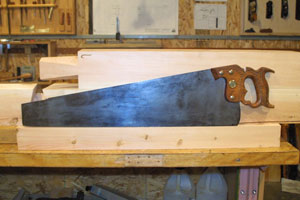
“I find it interesting and sad in a way that more woodworkers do not rely heavily upon the old tools. Maybe again, it is just me as I love history and have been part of the Mid-West Tool Collectors Association for the last 15+ years. Better than 75 percent of the tools I use regularly are from before WWI and many of my tools are from the Civil War era up to the 1880s. I love old tools and the fine craftsmanship that went into crafting them. I have an original Disston handsaw from around 1870 and a Stanley plane from the mid-1880s that I use regularly (dare I say daily). I don’t own a motorized planer and my table saw is seldom used (maybe once a month at most). I do use my electric drill, but I also enjoy using my large collection of bits and braces. My oldest tool that I use regularly would either be an 1840’s/1850’s brace or a screwdriver (straight tip, of course) handmade by a blacksmith from around this same timeframe.” – Andy Farthing
“I’m proud to say that most of my stationary machines are vintage, antique, or whatever you want to call them, and with a single exception relating to safety I wouldn’t have it any other way. The safety exception is riving knives on the table saws that move with and remain in close proximity to the blade, vs. the stationary splitters that I currently use. I’ve been a woodworker since the age of seven or eight, and that’s more than fifty years. I have some better-than-new hand tools that were my father’s and grandfather’s, and I’ve owned a ‘professional’ modern version of each stationary machine that I have. Those which were made in the U.S.A. were decent but nothing special; those made abroad were unacceptable, in some cases junk. Today’s companies are bought and sold regularly. Some trade on well-known quality brand names from yesteryear, while the expertise of long-time employees is thrown out along with parts inventories for any tool more than a few years old as manufacturing facilities are shuttered and ‘consolidated.’ Few modern machines are made to last, but the prices and marketing suggest enduring quality nonetheless.
“By the way, battery-powered tools are the biggest ripoff going. Sure they’re convenient, but at what cost? How many $80 battery packs will you buy for one tool, or how many perfectly operable tools will you throw away because it’s cheaper to replace the tool than to buy new batteries? Cordless tools have valuable uses and are safer in some applications, but many buyers have become convinced that any cordless tool trumps a corded one which costs less, works better and faster, and probably will outlast the battery one by several times. While at it, I’ll offer that while CNC driven equipment sounds great and does wonderful things, how many real woodworkers want their expensive equipment rendered obsolete every time the company is sold or comes up with a new, improved version and curtails support for the ‘old’ one that you bought two years ago? I’ll gladly use my powerful, durable, accurate machines from the 1930s, 40s, 50s, and 60s for as long as I’m able.” – Bill Pierce
“There are quite a few tools in my shop, but my favorite was purchased in 1958 when I was discharged from the Army. It built much of the furniture after I was married and then all manner of things for our children, grandchildren, great-grandchildren, many friends, my church and various civic organizations. The amazing thing is this Shopsmith model Mark 2 serial 85524 is still in use today and performs the various functions as good as the first time I used it. Much of the time now I leave it set up as a 12-inch disc sander. My table saw is on its third motor. I have worn out two chop saws, several routers, hand drills, turning tools, scroll saws and many other tools in 65 years of woodworking, but that old Shopsmith will continue to do its job long after my days have worn out.” – Roger Tumbleson
Of course, sometimes you can get parts — and make an old tool new again. – Editor
“A few years ago, I had been using my grandfather’s Porter-Cable router when a part broke and needed replacing. I called Porter-Cable’s customer service department to get the part. When I gave the rep the model number, he said there was no such number. I said there was, so he checked more. Sure enough, their archives showed that the model was the very first router they ever made, about 60 years old. After much research, it turned out the part I needed matched their existing router: the design had barely changed after 60 years. Sadly, the router only lasted another couple years til the motor burned out. I bought a new Porter-Cable hoping my son or grandson will be using it when I am just sawdust in the ground.” – Chris Ely
My father and brothers were contractors in Northern New Jersey. After they all retired, I was offered Dad’s table saw. It’s an old Craftsman and it needed work. I contacted Sears and they put me in touch with a group that specialize in old tools. Their site is www.owwm.org. Using that forum, I found that my dad’s saw was manufactured for Craftsman by a firm from Ohio and that it was originally made in 1938. I also found that, using the saw’s patent number, I could go directly to the U.S. Patent and get a copy of the design drawing for that saw. That part was a fun process. I started the process of rebuilding the saw. The trundles on this old beauty do not seem to be as adjustable as some newer saws, but then there is little to need adjusting. When I consider how this old cast-iron tool had bounced from job to job, it was in fair shape. I then changed the original fence to a Biesemeyer and added an anti-vibration belt and treated myself to a good Forrest blade. I have had the saw in good working and I have been using it for almost 10 years. I like it so much I even enjoy writing about it.” – Jim DiRenzo
Or, you can just rely on some clutter-clearing surprises to make an old tool new again. – Editor
“I have a Sears Craftsman Radial Arm saw (10″) with 3 or 4 original blades I still use. Bought it in March 1966. Have some attachments for it, too, that are handy; like a rotary planer, for instance. A bit difficult to keep it aligned at times, but worth the time to do it. Also have a Sears wood lathe that I bought circa 1971 on sale for $75, but it was stored behind stuff in the barn; I found it and began to use it in 2006. . . sorta like a brand-new 35-year-old lathe.” -Richard Coski
Long-lost relative? Or just a “woodworking” type name? – Editor
“The oldest tool I have in my workshop is a pad saw originally owned by my grandfather. It must date back to at least 1940. It is initialed RJ. His name was Robert Johnstone. Thought you would like to know.” – John Johnstone
A few more photos. – Editor
“Thought you might be interested; attached is a photo of my Dad’s 1963 Craftsman 9″ table saw. I don’t use it much, mostly for making rough cuts; the fence is not reliable and 9″ thin kerf blades are difficult to find. I have kept for mostly sentimental reasons. It stills runs pretty well ,but it takes a lot of setup to get a straight cut.” -Paul Milot
“Well, as it happens, the oldest working tool in my shop is an old saw, my grandfather’s misery whip. Granddad made his living with this saw, and another like it, when he was a young man in Tillamook County, Oregon. He was a bucker, the man who cuts felled trees into movable logs, and unlike the fellers, he worked alone in the woods. His tools were this saw, an axe, a couple of springboard ends (he made his own boards onsite), and a whiskey bottle full of kerosene on a forged hook (to lubricate the saw, if needed). The logs were very large, and securing them took as much time as cutting them, because if one rolled over onto him, it would be days before anyone found him.
“The saw has two handles, but Granddad was ever quick to point out that it was meant as a one-man saw. In use, it only had one handle and the other was kept as a spare. When the saw got dull in one direction, he would swap ends with the handle and start fresh on the other end, always cutting on the pull stroke. When he was done with a log, he would use his axe to make his mark that the mill would recognize, and it would be added to his tally. When the saw got dull, he would take it into the saw shop at the camp and exchange it for his other saw that had been sharpened in his absence.” – Tom Scott
And, finally, we received quite a few comments along these lines. – Editor
“Sad to say, but by far, the oldest tool in my shop that still works is myself. Although at my age, there are times that even I don’t work as I did in the past.” – Gerald Jones
